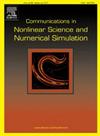基于向量多项式的6R机械臂解析运动学逆解与构型设计
IF 3.8
2区 数学
Q1 MATHEMATICS, APPLIED
Communications in Nonlinear Science and Numerical Simulation
Pub Date : 2024-12-20
DOI:10.1016/j.cnsns.2024.108546
引用次数: 0
摘要
高精度机械臂在航空航天、智能制造等行业中发挥着至关重要的作用。目前,工业机械臂通常采用球形手腕来获得解析解;然而,与制造相关的结构误差极大地降低了末端执行器的绝对定位精度,阻碍了高精度自主控制的发展。本研究针对机械臂进行了一系列的运动学建模、构型设计和解析反解,目的是在考虑工程限制的情况下提供精确有效的运动学反解。以向量多项式系统为关键前提,建立方程数最少、自变量数最少、数量级最少的迭代运动学模型。通过运动学模型中位置和姿态的解耦分析,提出了不受三轴相交约束的正交或平行机械臂构型设计。此外,利用Dixon消去法将逆运动学问题转换为多项式空间来解决。仿真得到了任意可达位置和姿态的八组运动学逆解。计算时间不超过2毫秒,位置和姿态相对误差均在10-15以内,提高了机器人运动学的计算精度。本文的工作为研制具有较高绝对定位精度和效率的机械臂提供了实用的运动学理论依据。本文章由计算机程序翻译,如有差异,请以英文原文为准。
Vector polynomial based analytical inverse kinematics and configuration design of 6R robotic arms
Robotic arms with high precision play a crucial role in industries like aerospace and intelligent manufacturing. Currently, industrial robotic arms typically adopt spherical wrists to obtain analytical solutions; however, manufacturing-related structural errors significantly reduce the end effector's absolute positioning accuracy, impeding the development towards high-precision autonomous control. This study presents a series of kinematic modelling, configuration design, and analytical inverse solutions for robotic arms with the goal of delivering precise and effective inverse kinematic solutions, while taking the engineering limitation into consideration. Taking the vector polynomial system as the key premise, an iterative kinematic model with the fewest number of equations, independent variables, and orders of magnitude is then established. Through decoupling analysis of the position and attitude in the kinematic model, configuration designs of robotic arms with orthogonal or parallel axes are proposed without adhering to the restrictions of three-axis intersection. Additionally, the inverse kinematic issue is addressed by conversion into polynomial space using the Dixon elimination approach. Eight sets of inverse kinematic solutions are obtained for any reachable position and attitude in simulation. The computation time does not exceed 2 milliseconds, and both position and attitude relative errors are below 10–15, enhancing computational accuracy for robot kinematics. The work of this paper provides a practical kinematic theory for the development of robotic arms with high absolute positioning accuracy and efficiency.
求助全文
通过发布文献求助,成功后即可免费获取论文全文。
去求助
来源期刊

Communications in Nonlinear Science and Numerical Simulation
MATHEMATICS, APPLIED-MATHEMATICS, INTERDISCIPLINARY APPLICATIONS
CiteScore
6.80
自引率
7.70%
发文量
378
审稿时长
78 days
期刊介绍:
The journal publishes original research findings on experimental observation, mathematical modeling, theoretical analysis and numerical simulation, for more accurate description, better prediction or novel application, of nonlinear phenomena in science and engineering. It offers a venue for researchers to make rapid exchange of ideas and techniques in nonlinear science and complexity.
The submission of manuscripts with cross-disciplinary approaches in nonlinear science and complexity is particularly encouraged.
Topics of interest:
Nonlinear differential or delay equations, Lie group analysis and asymptotic methods, Discontinuous systems, Fractals, Fractional calculus and dynamics, Nonlinear effects in quantum mechanics, Nonlinear stochastic processes, Experimental nonlinear science, Time-series and signal analysis, Computational methods and simulations in nonlinear science and engineering, Control of dynamical systems, Synchronization, Lyapunov analysis, High-dimensional chaos and turbulence, Chaos in Hamiltonian systems, Integrable systems and solitons, Collective behavior in many-body systems, Biological physics and networks, Nonlinear mechanical systems, Complex systems and complexity.
No length limitation for contributions is set, but only concisely written manuscripts are published. Brief papers are published on the basis of Rapid Communications. Discussions of previously published papers are welcome.
 求助内容:
求助内容: 应助结果提醒方式:
应助结果提醒方式:


